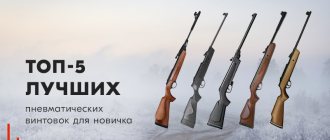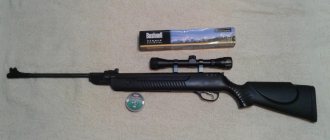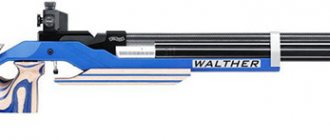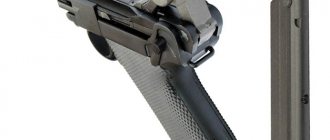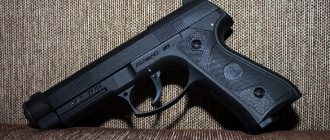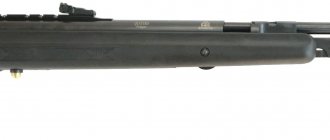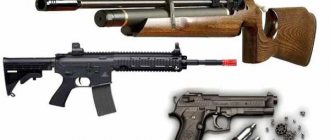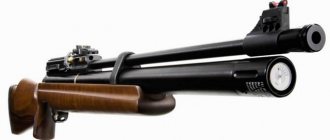Nothing complements the traditional May kebabs at the dacha more than shooting at cans or plinking - practicing accuracy is equally fun for both children and adults. The power of the pistols from our selection is below 3 joules, so you can shoot on your property or in any deserted place, knowing that you are not breaking the law.
These models are distinguished by their low price, ease of use and accuracy sufficient for shooting paper targets and cans. By the way, if you don’t know what the most important qualities for air pistols are, then read about it in our article at this link.
Baikal MP-53
Operating principle: spring-piston
Barrel - rifled
Type of ammunition - bullets
The real “grandfather” of modern air pistols, who is not going to retire. In the modern version, the MP-53M has lost the dovetail on the piston cylinder, but has acquired a softer trigger and an anatomical handle. The compressor volume is still small, but among air pistols it has almost no equal: the ejection speed of a half-gram bullet ranges from 90-100 m/s, which means it produces a power of about the declared 3 J.
This is a very accurate pistol that can give a head start in accuracy to all other models from the selection. We recommend it not only for recreational shooting, but also for the first steps in the sport of bullets.
+High power
+High accuracy
+Low price
-Poor quality of surface treatment, loose fit of parts and sharp corners
-Heavy weight
-Slow rate of fire
Pistol Baikal MP 53 M series spring-piston metal 4,790 ₽
Pistol Baikal MP 53 M series spring-piston metal
Add to cart
Features of sporting weapons
Before you begin to understand the question of what a sports air pistol is, it is recommended that you first learn about the main features of such weapons. It is usually customary to talk about four nuances:
- Availability of a license. To purchase a sports pistol or rifle, you must have a special license to carry and use such weapons (we will talk about how to obtain this document later). You won't be able to buy the model without it.
- Barrel type. There is a very important rule in sports shooting: only those athletes who own an air gun with a rifled barrel are allowed to compete. The use of smooth-bore models is for hunters.
- Specifications. Each sports pistol or rifle has certain indicators of power, mass and bullet speed. These values must not exceed those established by the international sports association.
- Design features. Sports weapons have a certain device, for example, a biathlon lever, a diopter sight or a breaking cocking mechanism. At the same time, some parts of the design are prohibited (choke tubes, optics).
However, these are only general features that are characteristic of sporting weapons in general. Do not forget that the requirements can change dramatically depending on the type of “instrument”, as well as the type of competition. For example, biathletes cannot use rifles with a standard stock, but are forced to purchase models with a bullpup, but those who participate in regular sports shooting have no such restrictions.
It is also important to understand that sporting weapons have a narrow specialization, which means they have a certain set of advantages and disadvantages. Before purchasing this or that model, it is recommended to carefully study the small block:
| Advantages | Flaws |
| Accuracy (sports pistols and rifles have good accuracy) | The need for frequent reloading (the main disadvantage of sports pneumatics is the lack of automation) |
| Balancing (in sports models the trigger is positioned so that the weapon has a good center of gravity) | Bullet speed and shot power (indicators are too low to use the weapon for purposes other than sport) |
| Availability of idle trigger (most sports models have the ability to simulate a shot, which is useful during training) | High percentage of air bleed (if you loaded a sports pistol, shoot, otherwise it will begin to lose its power) |
| The ability to independently replace parts (sports pneumatics are easy to modify) | The design of the weapon is not suitable for beginners, especially when it comes to professional weapons |
Of course, no one says that sports pneumatics must necessarily be used for performance in competitions. However, if the potential buyer does not pursue such goals, then it would be better to choose another type of weapon, for example, a hunting or recreational one.
Gamo P-900
Operating principle: spring-piston
Barrel - rifled
Type of ammunition - bullets
Another game-changing pistol, but unlike the MP-53, it is smaller: only 500 grams versus 1100 grams. Light weight is achieved due to the abundance of plastic in the design, but it is high-quality ABS plastic with excellent finishing.
The pistol feels good in the hand, is easy to control and has a good accurate shot with great power - with a half-gram bullet the ejection speed is 110 m/s.
+Low weight
+High power
+Low price
-Abundance of plastic parts in the design
-Tight spring charging
Pistol Gamo P-900 spring-piston metal plastic 5,090 ₽
Pistol Gamo P-900 spring-piston metal plastic
Add to cart
Training order
The algorithm for obtaining practical skills in using weapons is as follows:
- getting used to the gun and holding it with one or two hands;
- studying stances and techniques for quickly drawing weapons;
- a set of training exercises for aiming and firing;
- shooting from a combat pistol from racks at various distances;
- movements and actions to leave the line of fire;
- firing while moving.
Classes at the shooting range
First, sports exercises are mastered, then the practical direction of handling a pistol. At the last stage, the basics of a tactical nature are mastered. The main differences between combat shooting and sports and practical shooting are:
- bullet shooting competitions require high accuracy of hits;
- for practical shooting competitions, you first need to pass the standards, then the speed of performing the exercises;
- in combat duels, the main task is to survive, so shooting begins with leaving the line of fire, the movement does not stop until the enemy is physically destroyed.
Sports revolver shooting
Practical pistol shooting
Combat shooting on the move
Instructors pay special attention to psychological aspects and teach the student to control the consumption of ammunition. Only in combat shooting is firing from the hip, offhand and in motion, “swinging the pendulum” and other feints used that make it difficult for the enemy to aim fire.
Theory and incomplete disassembly
It is necessary to know the design of a weapon, if only because it needs to be reloaded and regularly cleaned and lubricated. Complete disassembly is used extremely rarely; the correct partial disassembly of a PM pistol is usually mastered. It is not recommended to start shooting practice with submachine guns and modifications with the ability to fire in bursts (Stechkin, Mauser). The design of the pistol looks like this:
- the frame with a hinged trigger guard is the power frame of the weapon;
- all other parts are removable;
- if disassembly is incomplete, remove the magazine, bolt and mainspring;
- the coiling of the spring is not symmetrical, it is put on the barrel from the side of the smaller diameter, as if screwing along a thread;
- When assembling, the shutter is slightly raised with its back side up and placed on the trigger mechanism with an energetic movement.
Incomplete disassembly of PM
All techniques and rules for shooting a pistol directly depend on its design. For example, if the weapon is not self-cocking, when the thumb of your strong hand is removed, the safety is removed, and the second hand moves the bolt to the rear position, chambering the cartridge in the firing position.
Distances for working with a pistol
By default, a pistol in the army is considered a personal weapon, not a small arms weapon. This is the last argument before hand-to-hand combat, and the ammunition is very limited compared to automatic weapons. In other words, in a combat situation, a pistol is part of self-defense, allowing you to survive, but in sports and practical shooting, on the contrary, targeted and high-speed shooting from a pistol is more important.
Hidden Weapon Detection
There are four distances with varying degrees of effectiveness for a fighter armed with a pistol:
- short – perimeter within two steps;
- close – radius 2 – 6 steps;
- medium – zone 6 – 12 steps to the enemy;
- farthest - 9 - 12 meters from the defender.
For short distances the following nuances are characteristic:
- severe stress to the point of stupor;
- there is not enough time to draw the pistol;
- Melee weapons are considered more effective.
Thus, training sessions should reinforce on a subconscious level an increase in distance when an enemy is detected 2 steps away from you.
Close distance is considered no less dangerous for a number of reasons:
- a knife and other bladed weapons remain quite effective at this distance;
- you need to shoot either while moving or after breaking the distance;
- An inexperienced defender is faced with the question of whether to shoot.
At close range, the subconscious often switches to a sports type of thinking. A static stance is adopted, the defender becomes fixated on drawing the weapon, forgetting about movements.
The middle distance is most convenient for a psychologically prepared shooter:
- enough time to determine the hostile intentions of the opponent and draw the weapon;
- no delays in movement, no tunnel vision effect;
- even when shooting from the midline of the body or from the hip, the defender confidently hits the target.
Long range is already a sporting type of bullet shooting; in practice it is rare. Ideal for pendulum techniques and two-gun low acrobatics.
Holding a weapon (grip)
Before developing the correct grip, you should start by practicing getting used to the weapon. Effective combat pistol shooting is only possible with the correct grip. The hand in which the weapon is located is called “strong”, the second, accordingly, “weak”. At the initial stage, it is recommended to train holding with two hands:
- the weapon fits into the palm of a strong hand;
- held by two fingers - the thumb from the inside, the middle one from the outside by the handle under the trigger guard;
- the little finger helps shape the position of the hand, but does not participate in the grip; it lies on the handle freely, without pressure;
- The ring finger is involved in the grip and lies on the handle.
Proper weapon holding
The butt plate of the pistol should be firmly seated in the groove of the hand between the thumb and index finger in both the horizontal and vertical directions. Grip strength is developed by exercise with the ball.
Fitting the butt plate into the fork
Then the same exercises are repeated for the weak arm. After this, the weak hand is connected to the “Two-handed” grip:
- she hugs the hand of a strong hand with a weapon;
- the thumb is located in front of the thumb of the strong hand in a similar position;
- the bent index finger supports the trigger guard from below.
Grab with both hands
Since delays in pistol shooting most often occur due to correcting incorrect holding, you should consolidate the last exercise with a partner and develop the technique.
Drawing a weapon
The easiest way to start drawing a pistol correctly is to master the exercise from behind the belt:
- the hand of a strong hand is formed into a “fork”;
- lightly hits the buttplate of the pistol;
- simultaneously grabbed with the middle and thumb;
- pulled out from under the belt.
Capturing the buttplate in the fork
Putting you in the line of fire
After a week of daily exercise, a speed type of draw is formed from a waist holster, then, if necessary, from an underarm holster. When following commands when firing a pistol, the draw is the initial movement.
The correct trajectory for drawing a weapon
Since in combat conditions you will have to fire from a Makarov pistol from different positions, the technique should include drawing the weapon while sitting on a chair, lying on your back, stomach and side.
Wrist workout
By default, the muscles of the hand and wrist form a “corset”, the strength of which determines the spatial position of the weapon at the time of the shot. It is necessary for the trainee to perform the following exercises to improve wrist strength:
- writing out figures or letters of the alphabet with the end of a long stick held in the hand;
- holding the weight in an outstretched strong, then weak hand;
- winding a rope with a suspended load alternately in different directions with the hands;
- push-ups on wrists and fists.
A set of exercises for the wrist muscles
Since in combat conditions they shoot not from a static stance, but in motion, and the weak hand is often occupied with other things, the wrists must be trained, and their muscle tone must be maintained by regular exercise.
Trigger processing
It’s easier to spend a week of time (half an hour of practice every day without breaks) than to burn cartridges trying to correct mistakes when performing shooting. For this purpose, an educational and developmental device is used:
- a paper cone 7–10 cm long is placed on the index finger placed on the trigger of the pistol;
- it is necessary to achieve smooth movement of the sharp end of the cone when selecting a free stroke and firing a shot.
Smooth descent training
The main mistake of shooting cadets is “waiting for a shot.” The finger tenses too much, pulls the trigger, the bullet has an unpredictable trajectory.
Racks
The most convenient position is a frontal stance when shooting a pistol with two hands. However, in real conditions it is necessary to conduct a duel with one hand or fire from two pistols, so the sequence of studying all types is discussed below.
Options for pistol shooting positions
For two-handed shooting
One stance is suitable for more effective performance of combat missions - the front one:
- the student stands facing the target;
- slightly bends the legs to absorb recoil and allow free movement in any direction;
- hands with weapons rise to shoulder level;
- the elbow of the strong arm is directed straight down, slightly bent;
- the elbow of the weak arm is slightly turned inward;
- the body leans forward to move the center of gravity closer to the tips of the toes.
Front stand
The basic rule is that in the projection of the shooter from above onto the ground, the arms and torso form a triangle.
For one-handed shooting
Take a stance for firing with one hand as follows:
- you need to stand sideways to the target, with a strong hand towards it;
- the toes of the feet are slightly spread in a natural, most comfortable position;
- both hands are raised to shoulder level, their position is selected to be as comfortable as possible for the shooter;
- then the weak hand lowers, and the strong one turns towards the target.
One-handed firing position
In this stance, called dueling, the silhouette is reduced by 50% compared to the frontal position. It is more difficult for the enemy to hit the cadet; the most important organ - the heart - is protected by the body by default.
For shooting with two pistols
Due to anatomical features, a person is not able to simultaneously aim from two pistols, therefore the classic frontal stance for firing with two hands with minor additions is considered the most effective:
- the weak hand does not support the strong hand, but provides a grip on the second weapon;
- The rigidity of the two pistols is ensured by pressing the thumbs against each other.
Grip two pistols for two-handed shooting
Thus, firing two barrels doubles the firepower. However, as an exception, there are options for firing from two pistols that solve a specific tactical problem.
When training, it is necessary to observe safety measures - the barrel of the pistol should always be pointed towards the target, when turning, the weapon tilts towards the ground and moves along the body.
Baikal MP-658 K
Operating principle: gas cylinder
Barrel - rifled
Type of ammunition - balls
This pistol has what the MP-654 lacked - a blowback function. Now the movable bolt rolls back when fired, creating a slight recoil sensation and a loud bang. Shooting from such weapons is more spectacular and interesting than from conventional air pistols.
The blowback uses up extra gas, and the pistol will fire fewer shots from one cartridge. Also of the minuses is the inconvenient system for loading cylinders and an incomplete magazine.
+Blowback
+High degree of similarity to the Makarov firearm
-Inconvenient recharging system
-Fewer shots from one cylinder compared to weapons without a blowback
Baikal MP 658 K gas pistol 4.5mm 8,490 ₽
Baikal MP 658 K gas pistol 4.5mm
Notify about arrival
Practical shooting
Practical shooting is a relatively new type of shooting sport that maximally imitates the real use of firearms. Here, in addition to the accuracy of the hit, the speed of hitting targets, the power of the weapon and the safety with which the athlete passes the distance are taken into account.
Practical shooting is distinguished by a variety of weapon classes and exercises. This sport uses both stock and modified pistols. The minimum caliber of cartridges is 9x19 mm. Externally, pistols may not differ from military weapons and are often sporting modifications of existing models. Practical shooting exercises are divided into medium, short and long, and differ in the number of shots.
Shooting is carried out at cardboard and metal targets. At the beginning of the distance, the shooter does not see all the targets; they open up to him when moving and changing firing positions. In practical shooting, moving targets, penalty and bonus targets, and various obstacles can be used. The shooter has to remember to reload the weapon, move frequently, choose comfortable shooting positions, or shoot while moving. All this makes practical shooting a dynamic and exciting spectacle.
LIST OF PISTOLS FOR IPSC DIVISION SERIAL (PRODUCTION)
Below is a list of the additions to the list of pistols currently approved for Production Division.
However, IPSC does not guarantee that a model currently listed may not be removed from the list in the future. IPSC reserves the right to modify this list at any time. Only handguns included in the full list of approved models and that comply with the requirements of Appendix D4 of the IPSC Handgun Competition Rules may be used in Production Division. For further information about the requirements of Production Division, please refer to Appendix D4 of the IPSC Handgun Rules, available for download from this website. For Action Air Production Division, only replicas of the handguns listed below are approved Updated: 2020-08-25
| Firearm | Model |
| AKDAL ARMS | Ghost TR01, TR02, TR03, TR07, TR08 |
| ALFA-PROJ | Alfa Combat, Alfa Defender |
| ARCHON | Type B |
| ARCUS | 98 |
| AREX | Rex Zero 1, Rex Zero 5.0, Rex Zero 1S, Rex Zero 1T, Rex Zero 1CP, Rex Alpha, Arex Delta M, Arex Delta M Gen2 and Arex Delta L |
| ARMA ZEKA | AZ P1 |
| ARMALITE | AR24, AR24K |
| ARMS MORAVIA | G2000 |
| ARMSCOR | AP9, AP9MS, APP9, APP9MS, MAP1, MAP1FS, MAP1MS, MAPP1 |
| ARSENAL FIREARMS | Strike One, Strike One Combat, Strike One Speed, Stryk B, AF1NITRO, Strike One Ergal, Strike One Ergal Pro |
| ASAI AG | onePRO |
| ASTRA | A75, A100 |
| BAIKAL | MP446, MP446C |
| BB TECH | BB6, |
| BERETTA | 92 Series full size frame (including 92, 92D, 92DS, 92F, 92FS, 92S, 92SB, 92SB-F, 92GSD, 92FS Brigadier, 92G, 92G Elite, 92G Elite II, 92FS Centurion, 92D Centurion, 92G Centurion, 92 Stock , 92EL, 90Two, 92A1, M9, M9A1, M9A3) 92 Series compact frame (including 92L Compact, 92SB Compact, 92L Compact M, 92SB compact M, 92 Custom Carry) 92X Performance 96 Series full size frame (including 96, 96D, 96DS, 96G, 96 Brigadier, 96D Brigadier, 96G Brigadier, 96G Elite, 96G Elite II, 96G-SD, 96 Centurion, 96D Centurion, 96 Stock), 96A1 96 Series Compact frame (including 96L Compact, 96L Compact M, 96D Compact , 96D Compact M) 98 Series (including 98F, 98FS, 98FS Brigadier, 98 Deluxe, 98 Stock, 98FS-A1) Vertec series (including 92G, 92FS, 92 Elite 1A, 92 Steel, 96G, 96FS, 96 Elite 1A, 96 Steel, 98 Steel) Cougar Series (including 8000 D/DL/FL/LP/Mini, 8040 D/F/Mini, 8045 D/F/Mini, 8357 D/F) 9000S Series (including Type D & F) PX4 Storm , APX NOT APPROVED: single-action-only variants or laser equipped models NOT APPROVED: Wilson Combat (or other custom shop) variants of any approved model above |
| BERNARDELLI | 2000, 2000 Baby |
| BERSA | Thunder 9, Thunder 40, Mini T9/T40, Thunder PRO/XT, BP9CC, TPR9,TPR9XT, TPR9T and TPR9X |
| BROWNING | BDM, BDA, PRO9, PRO40 NOT APPROVED: Hi-Power |
| BUL | Cherokee (full size, compact & mini), Impact, Storm AX F, AX FX, AX FST, AX C Cleaver, AX C Hatchet, AX C Tomahawk, AX FS Cleaver, AX FS Hatchet, AX FS Tomahawk |
| CANIK | Mkek series (Standard, Light, Compact), Piranha series (F, C, CF), Shark series C, Shark series FC, Stingray C, Dolphin, SFC-100, TP9V2, TP40V2, P120 (except SAO version). TP9DA, TP9SA, TP9SA Mod. 2, TP9SF, TP9SF Elite, TP9SF Elite-S TP9 Elite Combat NOT APPROVED: TP9SFx, |
| CARACAL | F, C, SC, CP660, CP661, CP662 NOT APPROVED: CP663, CP664 (due to lack of availability for inspection in early 2017). |
| COLT | 2000, Double Eagle Also approved: any DAO or DA/SA revolver with a barrel length of up to 127mm |
| CZ – CESKA STRAKONICE | ST9, TT9, TT40, TT45, MT9, MT9L |
| CZ – CESKA ZBROJOVKA | CZ75B Omega, CZ75 P-02, CZ75, CZ75B, CZ75B Stainless, CZ75BD, CZ75BD Police, CZ75 Compact, CZ75D Compact, CZ75 Semi Compact, CZ75 Combat II, CZ85, CZ85B, CZ85 Combat CZ40B, CZ97B, CZ99, CZ100, CZ1 10, CZ2075 Rami, CZ2075D Rami, CZ2075 Rami P CZ75 P01, P07, P07 Duty, P09, CZ75 SP-01, CZ75 SP-01 Tactical, CZ75 SP-01 Shadow, CZ75 SP01 Dual Tone, CZ75 SP-01 Sport (9x21mm version with OFM trigger stop as sold in Italy), CZ75 SP-01 Phantom, CZ75 SP-01 Shadow TR, CZ75 SP-01 Shadow Orange, Shadow 2, Shadow 2 Urban Grey, Shadow 2 OR (Optical Ready), Shadow 2 Orange, SP -01 Shadow Australian DualTone 9mm Pistol P10-C, P10-C OR P10-F, P10-F OR, P10-SC and P10 SC OR Also approved: variants with original (CZUB) barrels which are longer than standard (eg SP- 01A, SP-01DK), provided the barrel length does not exceed 127mm, and provided all other aspects of these variants fully comply with all other Production Division rules. Also approved: original (CZUB) dual tone, colored frame, and Shadow Line variants of approved models. NOT APPROVED: CZ-USA and CZ Custom Shop variants (eg SP-01 Shadow Target, CZ 75 Shadow T, CZ 75 SP01 ACCU Shadow etc.) NOT APPROVED: Frankonia models (eg Mamba, Viper etc.). |
| CZC – CZ CUSTOM | CZC A01-LD, CZC A01-SD, CZC 75 Bull Shadow |
| CZECHPOINT | NOT APPROVED: VZ-15 (due to lack of availability for inspection in early 2017). |
| DAEWOO | DP51, DH40 |
| DESERT EAGLE | Eagle Compact, Baby Eagle, Baby Desert Eagle III. |
| DIAMONDBACK | FS9 |
| DLASK | P226 clone |
| EAA | Witness Steel, Polymer, P, PS, P Carry, Classic, Limited Pro, Elite Stock, Stock II, Stock III, Pavona, Extreme Witness Stock 2, Extreme Witness Stock 3 Also approved: compact versions of the above models NOT APPROVED : Witness Carry Comp, Gold, Silver and Limited |
| FEG | P9R, P9RK |
| FMK FIREARMS | 9C1 G2 (DAO), |
| FN HERSTAL | FNP-9, FNP-9M, FNP-40, FNP-40M, FNP-9 DAO, FNP-40 DAO, FNP-45, FNP9-17 SA/DA, FNX9, FNX40, FNX45 FNS, FNS-9MS, FNS- 40MS, FNS-40L, FNS-9L (aka “Longslide”, previously FNS-9 Competition) 509 NOT APPROVED: FNX45 Tactical |
| GIRSAN | Bora, Bora Light, Compact MC, Compact MKEK, Regard MC, Regard MKEK, Zirve, MC23, MC23.40, MC23.45, MC27, MC-C40, MC-R40, MC-28SA, MC-28SAC, MC-28SAS MC-28SACS |
| GLOCK | 17, 17M, 19, 19M, 19X, 20, 21, 22, 23, 26, 27, 29, 30, 30S, 31, 32, 33, 36, 37, 38, 39, 43, 45. Also approved: variants with original Glock barrels which are longer than standard (eg 17A, 17DK), as well as variants with “Tactical”, “Mariner” or similar OFM engravings on the slide, provided the barrel length does not exceed 127mm, and provided all other aspects of these variants fully comply with all other Production Division rules. Also approved: Gen 4 and SF or FS versions of above models. Also approved: Gen 5 versions of above models. Also approved: MOS (Italy: FTO) versions but without optics fitted. Also approved: TB versions of approved models, provided the barrel length does not exceed 127mm. NOT APPROVED: 17TB, 18, 24, 25, 28, 34, 35, 41, 42, Pro, L, C models |
| GRAND POWER | K100, K100P40,K100P45, K100MK6, K100 Dynamic, K100MK7, K100 Target, K100 X-TRIM, P1, P1MK7, P1Ultra, GPC9, P11, P40L, P45L, Q100. X-Calibur (originally approved with barrel length checked with a caliper — remains approved even if the “dowel” method returns a different result), X-Calibur Match, X-Calibur Match CO. Also approved are variants with original Grand Power barrels which are longer than standard, provided the barrel length does not exceed 127mm, and provided all other aspects of these variants fully comply with all other Production Division rules. |
| HECKLER & KOCH | USP, USP Stainless, USP Compact, USP Compact Stainless, USP Custom Sport, USP9SD, USP Tactical (barrel 127mm or shorter), USP Compact Tactical, HK45, HK45 Compact VP70Z, P8, P9S (only with 100mm barrel), P10, P2000 , P2000SK, P30, P30L, P30S, P30LS, P7M8 (EP7 in Greece), P7M10, P7M13, VP9, VP9 Tactical, VP40, SFP9, SFP9-SF, SFP9-SFSD, SFP9L, SFP9-SK, SFP9-M, SFP9 -OR, SFP9L-OR, NOT APPROVED: Mark 23, USP Elite, USP Expert, USP Production, USP Combat Competition |
| HS PRODUCT | HS2000 Series (HS9, HS357, HS40, HS45) XDM (except ported models) HS-9 G2 4.0, HS-9 G2 4.0 SS (stainless steel slide), HS-9 G2 5.0, HS-9 G2 5.0 SS (stainless steel slide)HS SF19 3.8, HS SF19 3.8 SS, HS SF19 3.8 FDE, HS SF19 3.8 AFDE, HS SF19 3.8 TB cal, HS SF19 3.8 TB RDR, HS SF19 3.8 TB RDR AFDE, HS SF19 3.8 RDR, HS SF19 4.5, H.S. SF19 4.5 SS, HS SF19 4.5 FDE, HS SF19 4.5 AFDE, HS SF19 4.5 RDR, HS SF19 4.5 RDR SS NOT APPROVED: XDM 5.25 Series |
| HUDSON | H9 |
| IMI | Barak 9, Barak 40, Barak 45 |
| INDUMIL | Cordova |
| JERICHO | 941, 941S, 941F, 941FS, 941FB, 941FBL, 941R, 941RB, 941RS, 941PL/RPL, 941PSL/RPSL, 941FBL/RBL |
| KAHR | K Series (9mm,40cal, Lady & Elite), MK Series (9mm, 40cal, Micro & Elite), P Series (9mm and 40 cal), PM Series (9mm), T Series (Target & Tactical), TP Series |
| KALASHNIKOV | NOT APPROVED: PL14 (due to unavailability for inspection in early 2017). |
| KBP | GSh18 |
| KEL-TEC | P11, P40 |
| LAUGO ARMS | Alien |
| LLAMA | M-82 |
| MAGNUM RESEARCH | SP21 (9mm,40SW,45ACP), MR Eagle |
| MANURHIN | MR73 revolvers (3″ G3 and 4″ G4 models only) |
| NORINCO | NC226, NP18, NP22, NP34, NP40, NP58, NZ75, NZ85 |
| PARA-ORDNANCE | LDA NOT APPROVED: Tac-Five and other variants with enlarged magwells |
| PHOENIX | Fusion Standard, Fusion Standard Carry Optic, Fusion Tactical, Fusion Tactical Carry Optic, Fusion Compact. Redback, Redback Carry Optic, Redback Light, Redback Light Carry Optic, Redback Ultralight, Redback Ultralight Carry Optic. |
| REMINGTON | RP9, |
| REPUBLIC ARMS | Patriot |
| RUGER | P85, P89, KP89, P90, KP90, P91, KP93, P94, P95, K94/95, KP95, P345, KP345, KP345PR, P97, SR9, SR9C, SR40, KBSR9, LC9, P944, KP944, BSR45, KSR45, 9E, American, Also approved: any DAO or DA/SA revolver with a barrel length of up to 127mm |
| RWTS | NOT APPROVED: “Soratnik” (due to lack of availability for inspection in early 2017). |
| SARSILMAZ | Kilinc 2000, Kilinc 2000 Light, Hancer 2000, Hancer 2000 Light, K2, K10, K10C, B6, B6C, CM9, ST10 (not Tactical version), SAR 9, ST9. |
| SHADOW SYSTEMS | DR920, Combat and Elite models (threaded/non-threaded, without magwell) MR 920, Elite and Combat models (threaded/non-threaded) (without magwell ) MR918 9mm (MR918L, MR918 Combat, MR918 Elite without magwell) MR920L (threaded /non threaded, without magwell) |
| SCHMEISSER | SLP-9, |
| S.I.G. | P220, P220-1, P224, P225, P228, P229, P229 RX, P229 SL Sport, P239, P250, P250DCc, SP2009, SPC2009, SP2020, SP2022, SP2340, P320, P320 Carry, P320 Nitron, P320 RX (without opt ic ), P930, P227 series (various models), MK25 (without optic), P320 Compact, P320 X-VTAC, P320 X-Five (without detachable magwell), P320 Tacops Carry, P320 M17, P320 X5 Legion (without detachable magwell) , P226, P226 Tactical Operations, P226 E2, P226ST, P226 Sport II SL ohne Schiene, P226SL, P226SL Black, P226 X-Five Allround, P226 X-Five Tactical (not SAO version), P226R DAK, P226DAO, P226R, P226R Two Tone, P226 SAS, P226 Blackwater, P226 Equinox, P226 Stainless, P226 AL-SO, P226 SL-SO, P226 Sport Stock, P226 X-Five SO (SA/DA version only), P226 X-Five AL SO (SA/ DA version), P226 Navy, P226 SCT, P226 Elite, P226 Blackwater Tactical, P226 Combat, P226 Combat TB, P226 USPSA (Black & Two Tone), P226 Platinum Elite, P226 Enhanced Elite, P226 Elite Dark, P226 Gadsden, P226- SL-SO-BT, P226-MK25, P226 Elite Stainless, P226 Elite Dark TB, P226 Scorpion, P226 Scorpion TB, P226 X-Five SO Capsicum, P226 Extreme, P226 LDC, P226 LDC II, P226 RX Also approved: models listed above without the “P226” designation engraved on their slide provided the gun configuration is otherwise identical. Also approved are P220, P229, P239 and Legion series variants of approved models with maximum 127 mm barrel length. NOT APPROVED: P226 Xpress, P220 X-Zone, P220 Sport, P226 HSP, P226 Sport, P226 Sport II SL mit Schiene, P226 X-Five, P226 X-Five Short, P226 X-Five Competition, P226 X-Five Supermatch, P226 X-Six, P226R Crimson Trace, P320 Target. |
| SIGMA | Compact SW9V, SW40W, SW40VE, SW9VE, SW9M, SW40F, SW40C, SW9F, SW9C |
| SMITH & WESSON | 39, 59, 410, 439, 459, 539, 659, 669, 908, 910, 915, 1006, 1066, 3906, 3913, 3913L, 3913TSW, 3914, 3953, 3953STSW, 4006, 4043, 4046, 4013TSW, 4053TSW, 4513TSW, 4553TSW, 457, 4506, 4516, 4566, 4586, 5903, 5903TSW, 5904, 5906, 5946, 6906, 6926, 6946 SW99, M&P9, M&P9C, M&P9 Pro, M&P9L, M& P357, M&P40, M&P40L, M&P40 Pro, M&P45 , M&P45C, M&P40C, M&P9VTAC, M&P40 VTAC, M&P CORE Series, M&P CORE PRO Series, M&P M2.0, SD 9 VE Series, M&P9L Pro Series CORE, M&P Shield Series, M&P9TBK (but without optics fitted). Also approved: any DAO or DA/SA revolver with a barrel length of up to 127mm |
| SPHINX | 2000 Series (S, P, PS and H models) 3000 Series (Standard, Competition Production, Compact, Tactical, Police, SOP, Hi-Cap) All of the above in Steel, Stainless Steel, Titanium or Aluminum SDP Series (Compact, Compact Plus, Standard, Production) All of the above in Polymer, Steel, Stainless Steel, Titanium or Aluminum Also approved: variants with original Sphinx barrels which are longer than standard, provided the barrel length does not exceed 127mm, and provided all other aspects of these variants fully comply with all other Production Division rules. |
| SPRINGFIELD | P9, XD, XDS45, XDM (except ported models), XDM OSP (without optic), XD Mod.2 5″ Tactical, NOT APPROVED: XDM 5.25 Series, XD/XDM Production model, XD/XDM Custom Competition model |
| S.P.S. | Compact (SP II, SP II Plus, SP III) Police Compact (SPII, SPII Plus, SP3) |
| STAR | Megastar, M30, Ultrastar |
| STEYR | M-A1, M9-A1, M40-A1, S9, S40, L9-A1, C-A1. |
| STI | GP6, GP6C, GP5 Also approved: variants with original STI barrels which are longer than standard, provided the barrel does not exceed 127mm length, and provided all other aspects of these variants fully comply with all other Production Division rules. NOT APPROVED: single-action-only models |
| STOEGER INDUSTRIES | Cougar, Cougar Compact |
| STP | P19 |
| TANFOGLIO | Force 38, Force 38F Carry, Force 38F, Force 38L, Force 40, Force 40F Carry, Force 40F, Force 40L, Force 40R Carry, Force 40R, Force 45, Force 45F Carry, Force 45F, Force 45L, Force 45R Carry, Force 45R, Force 921, Force 921F Carry, Force 921F, Force 921L, Force 921R Carry, Force 921R, Force 99, Force Compact 40, Force Compact 45, Force Compact 921, Force Pro, Force Plus, Force Sport, GT10, GT21 Baby, GT21 Combat, GT21, GT23, GT40 Baby, GT40 Combat, GT40, GT45, P19 Combat, P19 Standard, P19L, P21 Combat, P21L, P23, P23L, P38L, P40 Compact, P40, P40F, P40FB, P40L, P40R , P41, P45, P45L, T94F, T94R, T95F Stock, T95F, T95R, T96F, T96R, T97F, T97L, T97R, TA10 Compact, TA10, TA40FB, TA45 Compact, TA45, TA90, TA90 Combat, XL2, XL4, Stock , Stock II, Stock III, Stock III Special, L, Combat Sport, TZ-75 C90, Limited PRO, S2N, Stock I, Stock II Xtreme, Stock III Xtreme, Stock IIIP. Stock I Optic, Stock II Optic, Stock II Xtreme Optic, Stock III Optic, Stock III Xtreme Optic, Stock IIIP Optic (but without optics fitted). Also approved: variants with original Tanfoglio barrels which are longer than standard (eg Stock II Limited) provided the barrel length does not exceed 127mm, and provided all other aspects of these variants fully comply with all other Production Division rules. NOT APPROVED: Stock Custom model |
| TARA | MP9, Millennium G2, TM-9, |
| TAURUS | PT92, PT99, PT100, PT100 Plus, PT101, PT111, PT140, PT145, PT921, M66, 827, 817, PT809B, PT809E, PT809SS, PT840B, PT840SS, PT845B, PT845SS, PT917, PT 917C, PT917CS, PT940 TS9, TH9, TH40 and TH 40C 24/7, 24/7 G2, 24/7 PRO DS, 24/7 LD Also approved: any DAO or DA/SA revolver with a barrel length of up to 127mm NOT APPROVED: 24/7 PRO, 24 /7 O.S.S. |
| TISAS | Zigana F, P40 |
| VEKTOR | SP1, SP2 (not Single Action), Z88 |
| WALTHER | P1, PPS, P5, P38, P88, P99, P99Q, P99QA, P99C, P99DAO, P99AS PPQ, PPQ-Navy, P99D-RAD, PPX, PPQ M2, PPQ M2 Navy SD, PPQ M2 Q4 TAC, PPQ Q5 Match, PPQ Q5 Match Champion, Creed. PPQ Q5 Match SF (Steel Frame), PPQ Q5 Match SF (Steel Frame) Champion (without detachable magwell). Also approved: compact versions of all above models Also approved: variants with original Walther barrels which are longer than standard provided the barrel length does not exceed 127mm, and provided all other aspects of these variants fully comply with all other Production Division rules. |
| XDB | RAPAX Sport |
| ZASTAVA | CZ99, CZ999, EZ, EZ Compact |
| ZEV TECHNOLOGIES | OZ9 Standard and Compact – without the detachable magwell. All models with a non-ported barrel. Not approved the OZ9 Competition with a barrel longer than 127mm (5 inch) |
| ZVS | P20, P21, |
